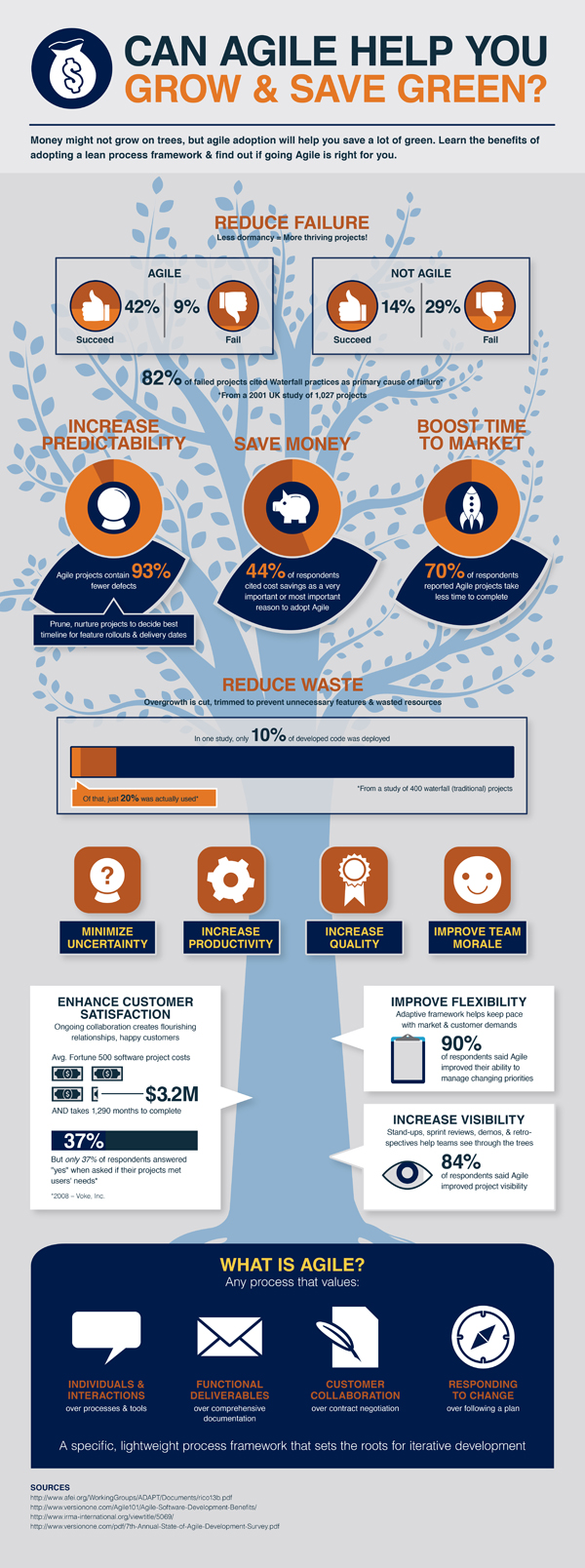Here's an overview:
What is Agile Software Development?
Agile software development is a methodology focused on iterative development, where cross-functional teams collaborate to deliver high-quality software quickly and efficiently. Here are some key aspects of Agile software development:
- Iterative Approach: Agile breaks the software development process into small increments, allowing for frequent reassessment and adaptation.
- Collaboration: Agile encourages constant communication and collaboration between team members, stakeholders, and customers throughout the development process.
- Adaptability: Agile is flexible and prioritizes responding to change over following a strict plan. Teams are encouraged to adapt to new information and adjust their approach accordingly.
- Customer-Centric: Agile places a strong emphasis on delivering value to the customer through early and continuous delivery of working software.
- Continuous Improvement: Agile teams regularly reflect on their processes and outcomes to identify areas for improvement and make adjustments to enhance productivity and quality.
- Transparency: Agile promotes transparency through tools like daily stand-up meetings, sprint reviews, and retrospectives, enabling stakeholders to track progress and provide feedback.
- Empowerment: Agile empowers team members to take ownership of their work, make decisions, and collaborate effectively to achieve project goals.
In summary, Agile software development offers a more dynamic and customer-focused approach to software development, emphasizing collaboration, adaptability, and continuous improvement to boost productivity and deliver high-quality software.
Principles of Agile Software Development
- Customer Collaboration over Contract Negotiation: Agile values customer collaboration throughout the development process. The idea is to involve customers in every stage to ensure the final product meets their needs and requirements.
- Responding to Change over Following a Plan: Agile embraces change by prioritizing responding to changes in requirements over sticking to a rigid plan. This allows teams to remain flexible and adapt quickly to evolving project needs.
- Individuals and Interactions over Processes and Tools: Agile focuses on the importance of effective communication and collaboration among team members. It values the contributions of individuals and emphasizes interactions over solely relying on processes and tools.
- Working Software over Comprehensive Documentation: Agile emphasizes the delivery of working software as the primary measure of progress. While documentation is essential, the focus is on producing a functional product rather than exhaustive paperwork.
- Embracing Change: Agile recognizes that change is inevitable in software development. Rather than resisting change, Agile teams welcome it, leveraging it to deliver better products efficiently.
- Regular Reflection and Adjustment: Agile encourages teams to regularly reflect on their processes and performance to identify areas of improvement. By continuously adjusting their methods, teams can optimize productivity and product quality.
These principles guide Agile software development practices, fostering collaboration, adaptability, and a customer-centric approach to product development and delivery.
Agile Methodologies and Frameworks
Agile methodologies and frameworks are the backbone of successful Agile software development. These methodologies guide the team through iterative processes, promoting flexibility, collaboration, and continuous improvement. Here are some popular Agile methodologies and frameworks:
- Scrum: One of the most widely used Agile frameworks, Scrum involves breaking down the work into small iterations called sprints. The team collaborates daily and holds regular meetings to track progress and adapt to changes quickly.
- Kanban: Kanban visualizes the workflow on a Kanban board with columns representing different stages of work. Teams pull work items through the stages, focusing on limiting work in progress and optimizing flow efficiency.
- Extreme Programming (XP): XP focuses on engineering practices such as test-driven development, pair programming, and continuous integration to ensure high-quality software delivery.
- Lean: Lean principles aim to eliminate waste, optimize resources, and deliver value to customers quickly. It emphasizes continuous improvement, customer collaboration, and respect for people.
- Crystal: Crystal methodologies come in different flavors based on team size, project priorities, and criticality. They prioritize communication, simplicity, and reflection to adapt to project needs effectively.
- Dynamic Systems Development Method (DSDM): DSDM provides a framework with principles and practices for iterative and incremental project delivery. It focuses on business value, active user involvement, and frequent delivery.
These Agile methodologies and frameworks offer guidance and structure to Agile teams, helping them stay focused, adapt to changes, and deliver high-quality products efficiently. By selecting the right methodology that aligns with the project requirements, teams can boost productivity and achieve successful outcomes in Agile software development.
How does Agile save you money? “cprime.com“

Scrum: An Overview
Scrum is a popular framework used in Agile software development to manage complex projects. Here is an overview of Scrum:
- Roles: In Scrum, the team consists of three primary roles: the Product Owner who represents the stakeholders, the Scrum Master who ensures the Scrum process is followed, and the Development Team responsible for delivering the product increment.
- Artifacts: Scrum defines specific artifacts to facilitate communication and transparency within the team. These include the Product Backlog, Sprint Backlog, and Increment.
- Sprints: Sprints are time-boxed iterations, usually lasting between one to four weeks, during which specific work is completed and ready for review.
- Meetings: Scrum prescribes several meetings to keep the team aligned and informed. The Daily Stand-up, Sprint Planning, Sprint Review, and Sprint Retrospective are essential gatherings in the Scrum framework.
- Flexibility: One of the key principles of Scrum is its adaptability. It allows for flexibility in changing requirements, ensuring that the product adapts to market needs swiftly.
- Continuous Improvement: Scrum promotes a culture of continuous improvement through regular reflection and adjustment. By reviewing processes at the end of each sprint, Scrum teams strive to optimize productivity and product quality.
Scrum is widely adopted by software development teams for its focus on collaboration, transparency, and adaptability. Understanding the foundational elements of Scrum is crucial for implementing Agile principles effectively in project management.
Roles in Agile Software Development
In Agile software development, there are several key roles that contribute to the success of a project. These roles are essential for maintaining the iterative and collaborative nature of Agile methodologies. Here are some of the primary roles in Agile software development:
- Product Owner: The Product Owner is responsible for defining and prioritizing the features of the product. They act as the voice of the customer and ensure that the development team is working on the most valuable tasks.
- Scrum Master: The Scrum Master is the facilitator of the Agile team. They ensure that team members are following Agile practices and principles. Scrum Masters also help to remove any obstacles that may hinder the team’s progress.
- Development Team: The Development Team is responsible for delivering working software at the end of each iteration. Team members collaborate closely to create high-quality software that meets the requirements set by the Product Owner.
- Stakeholders: Stakeholders are individuals or groups with an interest in the project. They provide feedback, guidance, and support throughout the development process. Regular communication with stakeholders is crucial for Agile projects.
- Quality Assurance (QA) Team: The QA team is responsible for ensuring that the software meets quality standards. They work closely with the development team to test the software, identify bugs, and ensure that the final product is of high quality.
Each role in Agile software development plays a crucial part in the success of a project. By working together collaboratively and following Agile principles, teams can deliver high-quality software efficiently and effectively.
Common Practices in Agile Development
- Regular Stand-Up Meetings: Agile teams hold daily stand-up meetings to discuss progress, challenges, and plans for the day. These short meetings promote collaboration, transparency, and quick issue resolution.
- Iterative Development: Agile development breaks down the project into smaller iterations or sprints. Each iteration typically lasts two to four weeks and ends with a potentially shippable product increment.
- Continuous Integration: Developers merge their code changes into a shared repository several times a day. This practice helps to identify and address integration issues early and ensures that the codebase is always up-to-date.
- Cross-functional Teams: Agile teams are composed of individuals with diverse skills such as developers, designers, testers, and product owners. This diversity fosters collaboration and allows for more holistic product development.
- User Involvement: Agile encourages regular feedback from end-users throughout the development process. By involving users early and often, teams can adapt to changing requirements and deliver a product that meets user needs.
- Embracing Change: Agile recognizes that requirements are likely to change during a project. Teams are encouraged to be flexible and responsive to change, adapting their plans and priorities as needed.
- Retrospectives: At the end of each iteration, teams hold retrospectives to reflect on what went well, what could be improved, and how to implement those improvements in the next iteration. This continuous feedback loop helps teams to learn and grow over time.
Agile development emphasizes collaboration, adaptability, and a focus on delivering value to customers. By following these common practices, teams can harness the power of Agile methodologies to boost productivity and achieve success in their projects.
Advantages of Agile Software Development
- Increased Flexibility: Agile development allows for changes to be made throughout the project, providing flexibility to adjust priorities and features based on feedback and evolving requirements.
- Faster Delivery: By breaking the project into smaller increments, Agile development enables teams to deliver working software more frequently, accelerating the overall development process.
- Enhanced Collaboration: Agile methodologies emphasize communication and collaboration among team members, stakeholders, and customers. This leads to better alignment of expectations and quicker decision-making.
- Improved Quality: Continuous testing and feedback loops in Agile development help identify and address issues early, leading to higher-quality software and reduced rework.
- Better Stakeholder Engagement: Agile involves stakeholders in every stage of the development process, ensuring their feedback is incorporated promptly and resulting in a product that better meets their needs.
- Higher Customer Satisfaction: The iterative nature of Agile development enables teams to receive feedback from customers regularly, leading to a product that aligns closely with customer expectations and ultimately higher satisfaction.
- Risk Mitigation: Agile’s incremental approach allows teams to identify and mitigate risks early in the project, reducing the likelihood of major issues arising later in the development cycle.
- Adaptability to Change: Agile methodologies embrace change as a natural part of the development process, allowing teams to respond quickly to market shifts, technological advancements, or new priorities.
- Increased Transparency: Agile development practices such as daily stand-up meetings and regular demos provide transparency into the project’s progress, fostering trust among team members and stakeholders.
- Enhanced Productivity: By promoting a collaborative and iterative approach, Agile development helps teams stay focused, motivated, and productive throughout the project duration.
Challenges and Misconceptions of Agile
- Misconception: Agile means no planning
- Misconception: Agile is just for small teams
- Misconception: Agile is only for software development
- Challenge: Resistance to change from traditional methods
- Challenge: Lack of understanding of Agile principles
- Challenge: Difficulty in adapting Agile in large organizations
Agile methodology often faces challenges and misconceptions, hindering its adoption and effectiveness. One common misconception is that Agile means no planning. In reality, Agile emphasizes iterative planning and adaptability. Another misconception is that Agile is only suitable for small teams. Agile principles can be scaled effectively for larger teams and organizations.
Some challenges include resistance to change from traditional methods. Individuals accustomed to traditional waterfall approaches may find Agile unfamiliar and resist the transition. Moreover, there may be a lack of understanding of Agile principles, leading to misinterpretation and misuse of Agile practices.
Another significant challenge is the difficulty in adapting Agile in large organizations. Implementing Agile across multiple departments and teams can be complex and require a shift in organizational culture. Overcoming these challenges and addressing misconceptions is essential for successful Agile implementation and maximizing its benefits.
Implementing Agile in Your Organization
- Assess Current Processes:
- Evaluate the existing workflows and identify areas that could benefit from Agile methodologies.
- Conduct a thorough analysis to understand the strengths and weaknesses of the current processes.
- Train Teams:
- Provide comprehensive training sessions to ensure everyone understands the Agile principles and practices.
- Offer specialized training for specific roles like Scrum Masters and Product Owners.
- Create Cross-Functional Teams:
- Form teams with members from different departments to encourage collaboration and diversity of skills.
- Encourage team autonomy and decision-making to enhance productivity.
- Establish Clear Goals and Objectives:
- Define clear, achievable goals for each sprint or iteration.
- Ensure that all team members understand the project’s objectives and their role in achieving them.
- Implement Regular Feedback Sessions:
- Schedule regular feedback sessions to review progress, address challenges, and make necessary adjustments.
- Use feedback to continuously improve processes and deliver high-quality products.
- Embrace Change and Adaptation:
- Encourage a culture of flexibility and openness to change.
- Emphasize the importance of adapting quickly to customer feedback and market demands.
- Utilize Agile Tools:
- Implement specialized Agile tools like Jira, Trello, or Kanban boards to facilitate project management.
- Use collaborative platforms to enhance communication and transparency within teams.
- Celebrate Achievements:
- Acknowledge and celebrate both small and big achievements to boost team morale.
- Recognize individual and team contributions to foster a positive work environment.
By following these steps and fostering an Agile mindset within your organization, you can effectively implement Agile practices to enhance productivity, improve product quality, and drive innovation.
The Agile Manifesto and its Principles
The Agile Manifesto was created by a group of software developers to revolutionize the software development process. It emphasizes values and principles that prioritize individuals and interactions over processes and tools, working software over comprehensive documentation, customer collaboration over contract negotiation, and responding to change over following a plan.
The Agile Manifesto consists of four key values:
- Individuals and Interactions over Processes and Tools: Agile values the contributions of people within a team and promotes effective communication and collaboration to drive project success.
- Working Software over Comprehensive Documentation: The primary goal of Agile is to deliver a functional product. While documentation is essential, working software takes precedence.
- Customer Collaboration over Contract Negotiation: Agile encourages active involvement of customers throughout the development process to ensure the end product meets their needs and expectations.
- Responding to Change over Following a Plan: Agile acknowledges that change is inevitable in software development. It promotes flexibility and the ability to adapt to changing requirements.
The twelve principles of Agile software development include:
- Customer satisfaction through early and continuous software delivery.
- Welcome changing requirements, even late in development.
- Deliver working software frequently, with a preference for shorter timescales.
- Businesspeople and developers must work together daily throughout the project.
- Build projects around motivated individuals and give them the environment and support they need.
- The most efficient way of conveying information is face-to-face conversation.
- Working software is the primary measure of progress.
- Agile processes promote sustainable development.
- Continuous attention to technical excellence and good design enhances agility.
- Simplicity is essential.
- Self-organizing teams promote the best architectures, requirements, and designs.
- At regular intervals, the team reflects on how to become more effective and adjusts its behavior accordingly.
Key Differences Between Agile and Waterfall
- Approach:
- Agile: Iterative and incremental approach with flexibility for changes throughout the development process.
- Waterfall: Sequential approach where each phase must be completed before moving on to the next.
- Flexibility:
- Agile: Allows for changes and updates to be implemented at any point in the project timeline.
- Waterfall: Changes are difficult and costly to implement once a phase is completed.
- Feedback:
- Agile: Encourages regular feedback from customers and stakeholders, leading to continuous improvements.
- Waterfall: Feedback is typically gathered at the end of the project phases.
- Risk Management:
- Agile: Risks are identified and addressed throughout the project, reducing the likelihood of large-scale failures.
- Waterfall: Risks are not addressed until the testing phase, which can lead to significant challenges if issues arise.
- Delivery Time:
- Agile: Delivers working software in short iterations, allowing for quicker response to market changes.
- Waterfall: Longer delivery time due to sequential nature of the process.
- Client Involvement:
- Agile: Clients are involved throughout the development process, providing continuous feedback and ensuring the final product meets their needs.
- Waterfall: Clients are involved primarily at the beginning and end of the project.
- Documentation:
- Agile: Emphasizes working software over comprehensive documentation, focusing on requirements and deliverables.
- Waterfall: Requires extensive documentation at each phase of the project.
These key differences highlight the contrasting approaches of Agile and Waterfall methodologies, each with its own benefits and challenges.
Agile Project Management Tools
- Agile methodologies rely on various project management tools to facilitate collaboration, communication, and organization within teams.
- Kanban Board: Visualizes workflow stages, tasks, and priorities, enabling teams to track progress and identify bottlenecks easily.
- Scrum Board: Organizes tasks into sprints, tracks progress in daily stand-up meetings, and ensures transparency and accountability.
- Burndown Charts: Illustrate remaining work over time, helping teams manage and adjust their pace to meet project deadlines.
- Backlog Management Tools: Prioritize user stories and tasks, ensuring teams work on high-value items first to deliver customer value quickly.
- Collaboration Platforms: Tools like Jira, Trello, or Asana centralize communication, document sharing, and task assignments, fostering team collaboration.
“Agile project management tools play a crucial role in enhancing team productivity, enabling effective communication, and improving project transparency.”
Ensuring Quality in Agile Development
- Agile software development emphasizes the importance of high-quality outcomes throughout the development process.
- Continuous Testing: Agile teams conduct testing at every stage of development to ensure that the product meets quality standards.
- Regular Reviews: Regular reviews and feedback sessions are held to address any quality concerns and make necessary adjustments.
- Collaboration: Constant collaboration between team members helps in identifying and resolving quality issues early on.
- Automated Testing: Agile teams utilize automated testing tools to speed up the testing process and maintain high quality.
- Feedback Loops: By incorporating feedback loops, Agile teams can quickly address quality issues and implement improvements.
- Adaptive Planning: Agile allows for adaptive planning, ensuring that changes can be made to improve quality at any stage of development.
- Continuous Integration: Continuous integration practices help in identifying and fixing quality issues as soon as they arise.
- Iterative Development: The iterative approach of Agile allows for regular inspection and adaptation to maintain quality standards.
- Quality Assurance: Agile development includes dedicated quality assurance roles to oversee and ensure the quality of the final product.
In Agile development, quality is not just a goal but a fundamental principle that guides the entire process. By continuously focusing on quality throughout each stage, Agile teams can deliver high-quality products that meet customer expectations and business needs.
Continuous Integration and Continuous Delivery in Agile
Continuous Integration (CI) and Continuous Delivery (CD) are essential practices in Agile software development that aim to streamline the development process and ensure high-quality software delivery.
- Benefits of Continuous Integration:
- Automatically integrates code changes made by multiple developers into a shared repository on a regular basis.
- Helps in detecting and addressing integration errors early in the development cycle.
- Ensures that the codebase is always in a deployable state.
- Key Practices for Continuous Integration:
- Automated Builds: Automate the build process to compile code and run automated tests.
- Version Control: Use a version control system to track changes made to the codebase.
- Automated Testing: Implement automated testing to ensure code quality and detect bugs early on.
Continuous Delivery complements CI by automating the deployment process, allowing teams to release software updates quickly and frequently.
- Benefits of Continuous Delivery:
- Enables teams to deliver new features to users faster.
- Reduces the risk associated with manual deployment processes.
- Enhances collaboration between development, operations, and testing teams.
- Key Practices for Continuous Delivery:
- Deployment Automation: Automate the deployment process to streamline releases.
- Configuration Management: Manage application configurations to ensure consistency across environments.
- Monitoring and Feedback: Implement monitoring tools to gather feedback on the deployed software.
By implementing CI/CD practices in Agile, teams can achieve faster development cycles, improved collaboration, and higher-quality software releases.
Scaling Agile for Large Projects
- Cross-functional Teams: Agile principles emphasize the importance of cross-functional teams encompassing various skills and expertise to address complexities in large projects effectively.
- Scrum of Scrums: Implementing a “Scrum of Scrums” approach can help coordinate multiple Scrum teams working on interconnected tasks within a large project.
- Release Planning: Developing a clear release plan that outlines milestones, dependencies, and priorities is essential for managing large projects efficiently within the Agile framework.
- Continuous Integration: Utilizing continuous integration practices ensures that code changes from multiple team members are integrated and tested frequently, reducing integration issues in large-scale projects.
- Regular Retrospectives: Conducting regular retrospectives allows teams to reflect on their processes, identify areas for improvement, and make necessary adjustments to enhance productivity in large Agile projects.
- Scaled Agile Framework (SAFe): Implementing frameworks like SAFe can provide a structured approach to scaling Agile practices across large organizations, enabling streamlined collaboration and delivery.
- Agile Tooling: Leveraging Agile project management tools that support scalability, collaboration, and visibility can facilitate the management of large projects and enhance overall productivity.
- Scalable Architecture: Developing a scalable architecture design that can accommodate the evolving requirements of large projects is crucial for adapting quickly to changes and ensuring flexibility within the Agile development process.
- Stakeholder Collaboration: Effective communication and collaboration with stakeholders throughout the project lifecycle are vital for aligning priorities, managing expectations, and ensuring successful delivery in large Agile projects.
Building a Collaborative and Adaptive Culture
- Agile software development thrives on collaboration among team members. It emphasizes the importance of open communication and frequent interactions to achieve project goals efficiently.
- Team members in an agile environment work together closely, share ideas, and collaborate on finding solutions. This culture fosters creativity and innovation as different perspectives come together to solve problems.
- By promoting a collaborative culture, agile teams can adapt quickly to changes in requirements or priorities. The flexibility of agile methodologies allows teams to adjust their plans and processes to deliver high-quality software within short iterations.
- Building a collaborative and adaptive culture requires trust among team members. It is essential for team members to trust each other’s expertise, decisions, and contributions to work effectively towards a common goal.
- Agile encourages continuous feedback loops, both within the team and with stakeholders. This feedback helps teams make informed decisions, prioritize effectively, and improve processes iteratively.
- Embracing change is a fundamental aspect of building a collaborative and adaptive culture. Agile teams understand that change is inevitable and use it as an opportunity to learn, grow, and deliver better results.
- Ultimately, creating a culture of collaboration and adaptability leads to increased productivity, higher-quality software, and more satisfied stakeholders in agile software development projects.
Measuring Success in Agile Projects
- Agile projects measure success through the following key performance indicators:
- Sprint Velocity: This metric tracks how many user stories or points a team can complete in a sprint. A consistent increase in velocity indicates improved productivity.
- Burn-down Charts: These visual representations show the remaining work in a sprint. A steep downward slope indicates that the team is efficiently completing tasks.
- Customer Satisfaction: Regular feedback from the customer helps gauge whether the delivered product meets their needs and expectations.
- Cycle Time: This metric measures how long it takes for a user story to move from the “in progress” stage to completion. A shorter cycle time signifies higher efficiency.
- Defect Rate: Monitoring the number of defects found during development and after product release helps improve quality over time.
- Team Happiness: The happiness and engagement of team members directly impact productivity and the overall success of the project.
- Adaptability: Agile projects can adapt to change quickly. The ability to incorporate new requirements or pivot strategies indicates the project’s success in responding to market dynamics.
Regular retrospectives and reviews allow Agile teams to reflect on their processes and make continuous improvements, contributing to the success of the project.
By consistently monitoring these indicators and adapting based on the feedback received, Agile projects can enhance productivity, deliver value to customers, and achieve success.
The Future of Agile Software Development
- Agile software development continues to evolve as technology advances and market demands change.
- Embracing Agile methodologies offers companies the flexibility and adaptability needed to stay competitive in a rapidly changing landscape.
- The future of Agile software development will see increased integration with emerging technologies such as artificial intelligence and machine learning.
- Teams will need to leverage automation and data analytics to streamline processes and make data-driven decisions.
- Agile practices will continue to focus on collaboration, communication, and cross-functional teams to deliver high-quality software products efficiently.
“As Agile methodologies mature, organizations will need to prioritize continuous improvement and learning to stay ahead in the competitive tech industry.”
- The Agile approach will extend beyond software development to other areas of the organization, fostering a culture of agility and innovation.
- With the rise of remote work and distributed teams, Agile software development will adapt to new collaboration tools and communication strategies.
- Companies will place a greater emphasis on customer feedback and engagement to drive product development and iteration.
- Agile frameworks like Scrum and Kanban will remain popular choices for managing projects, with a continuous focus on delivering value to customers.
Overall, the future of Agile software development lies in its ability to embrace change, prioritize customer satisfaction, and empower teams to deliver high-quality products efficiently in a dynamic and competitive market.
Case Studies and Success Stories of Agile Implementation
- In one case study, a large tech company implemented Agile methodologies to streamline their software development process. By breaking down projects into smaller iterations, they were able to deliver new features to customers more frequently, resulting in increased customer satisfaction and faster time-to-market.
- Another success story comes from a financial services company that adopted Agile practices to improve collaboration between their development and operations teams. This led to a significant reduction in time spent on fixing bugs and deploying new features, ultimately resulting in a more efficient and productive work environment.
- A healthcare organization also experienced the benefits of Agile implementation. By using Agile frameworks such as Scrum and Kanban, they were able to respond quickly to changing market demands and deliver high-quality products to their customers. This resulted in improved patient outcomes and increased staff morale.
Agile methodologies have proven to be highly effective in various industries, allowing organizations to adapt to change quickly and deliver value to customers more efficiently.
- By embracing Agile principles, companies can overcome traditional waterfall challenges, such as long development cycles and difficulty responding to customer feedback. Agile empowers teams to be more flexible, transparent, and collaborative, leading to increased productivity and innovation.
- Overall, the case studies and success stories of Agile implementation highlight the transformative impact it can have on organizations of all sizes and industries. By embracing Agile methodologies, companies can achieve higher productivity, improved customer satisfaction, and a competitive edge in today’s fast-paced business landscape.
Conclusion and Final Thoughts
- Agile software development is a proven methodology that prioritizes flexibility, collaboration, and rapid adaptation to changes throughout the development process.
- Embracing Agile practices can significantly boost productivity by promoting continuous improvement, transparency, and customer satisfaction.
- The iterative nature of Agile allows for quicker delivery of valuable software increments, resulting in faster time-to-market and increased stakeholder engagement.
- Agile teams benefit from increased motivation and morale due to a focus on self-organization, regular feedback, and a shared sense of ownership.
- Continuous communication and close collaboration among team members, stakeholders, and customers are essential components of successful Agile implementations.
- By incorporating Agile principles and methodologies into their workflows, organizations can adapt more effectively to evolving market conditions and customer needs.
- It is crucial for Agile teams to prioritize simplicity, flexibility, and a customer-centric approach to ensure the success of their projects.
- Embracing an Agile mindset requires a commitment to continuous learning, adaptation, and an openness to change for both individuals and organizations.
- Agile’s emphasis on empirical data, short feedback loops, and frequent retrospectives enables teams to identify areas for improvement and implement changes quickly.
- In conclusion, Agile software development offers a powerful framework for enhancing productivity, fostering innovation, and delivering high-quality software solutions in today’s fast-paced and competitive business environment.




